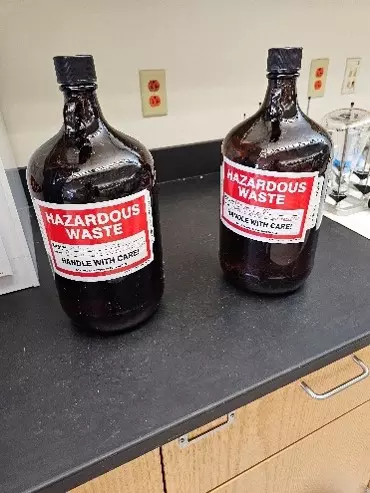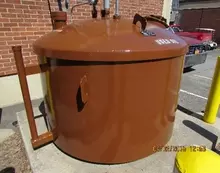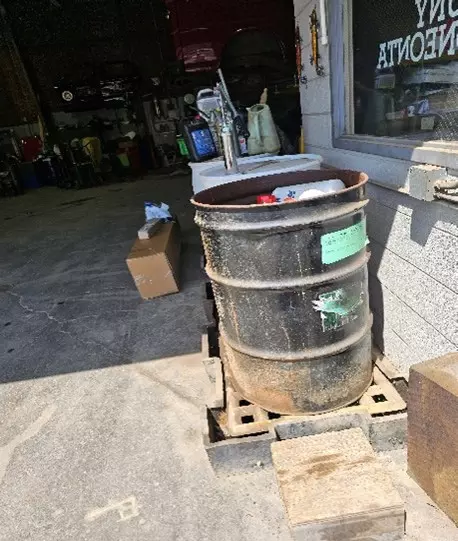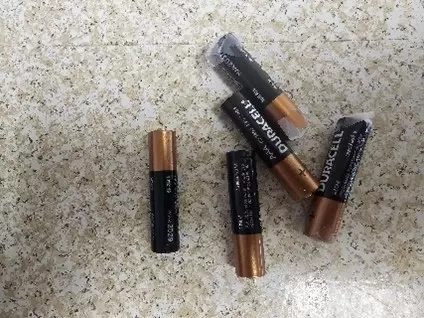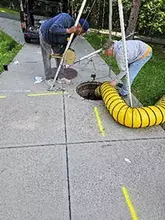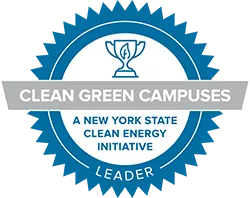Role of the Department of Environmental, Health and Safety
SUNY Oneonta is committed to providing a safe and healthy environment for all persons associated with the University, including students, faculty, staff, visitors and the local community.
The Environmental, Health and Safety (EHS) department supports the University’s core value and mission by proactively recognizing and controlling health and safety hazards, ensuring regulatory compliance, engaging all stakeholders, and minimizing future potential liabilities. EHS provides leadership for the University health and safety programs, by developing EHS programming unique to each area on campus, implementing lean methodologies, performing various inspections/audits and tracking key performance indicators (KPIs).
Safety is a shared responsibility. Department heads, principal investigators, faculty members, and supervisors are directly responsible for ensuring full compliance with local, State (PESH, DEC) and Federal regulations and the University’s safety policies and procedures.
The Environmental, Health and Safety department has the authority to prohibit, stop, or otherwise limit potential environmental or occupational harm to individuals, community, or the environment.
Education/Training
The Environmental Health and Safety Department provides extensive training to the campus community. OSHA/PESH requires employers to provide training to workers who face hazards on the jobs. One of the ways the EHS department meets its mission is by providing principal investigators, students, supervisors, and workers with:
- Knowledge and skills needed to do their work safely and avoid creating hazards that could place themselves or others at risk.
- Awareness and understanding of workplace hazards and how to identify, report, and control them.
Additional training may be needed depending on the roles assigned to workers. Supervisors may need specific training to ensure that they can fulfill their roles in providing leadership, direction, and resources for the safety and health program. Workers assigned specific roles in the program (e.g., incident investigation team members) may need training to ensure their full participation in those functions.
ADDIE Model
The acronym “ADDIE” stands for Analyze, Design, Develop, Implement, and Evaluate. It is an instructional design model that helps think through training design. The SUNY Oneonta EHS department implemented the ADDIE model as it aligns instructional activities with learning objectives and goals.
Contact the EHS department (Osamede.Evbuomwan@oneonta.edu) to schedule trainings for any of the following topics:
- OSHA 10 Hours General Industry
- OSHA 10 Hours Construction Industry
- OSHA 30 Hours General Industry
- OSHA 30 Hours Construction Industry
- HAZWOPER (40) Hours
- HAZWOPER Refresher
- Permit Required Confined Space
- Respiratory Protection Program
- Hazard Communication
- Lab Safety
- Hearing Conservation Program
- Golf Cart
- Asbestos
- Mold
- Ergonomics
- Ladder
- Bloodborne Pathogen
- Lockout/Tagout
- Therma Stress
- Machine Guarding
- Studio Safety
- Hazardous Waste
- Universal
- Environmental Compliance
- Fire Prevention
- Walking Working Surface.
- Ventilation
- Industrial Hygiene
- Lean Methodologies
- Hand and Power Tools
- Indoor Air Quality
- Electrical Safety
- Fall Protection
- On-Boarding Safety Orientation (with HR)
- Aerial Lifts
- Silica
Environmental Compliance
SUNY Oneonta is committed to meeting its environmental obligations efficiently and cost effectively. Environmental compliance program provides safety and compliance guidelines, services and resources to the students, faculty, and staff. The Environmental Health and Safety Department conducts regular environmental audits/inspection to ensure compliance and continuous improvement. The University’s key environmental compliance programs are as follows:
Environmental Health & Safety ensures SUNY Oneonta dispose hazardous waste in accordance with applicable State and Federal regulations (cradle to grave). This includes correctly identifying waste, storing waste properly, performing required weekly inspections, and making sure that all storage time limits are met. Our resources can help you label and ship waste materials.
The goal of this regulation is to prevent oil from reaching navigable waters and adjoining shorelines, and to contain discharges of oil. The regulation requires SUNY Oneonta to develop and implement Spill Prevention, Control, and Countermeasure (SPCC) Plans and establish procedures, methods, and equipment requirements. Any spill or release of oil at SUNY Oneonta must be reported to EHS immediately and handled in accordance with the University’s Oil Spill Response Plan.
Stormwater Management is the process of controlling the stormwater runoff that comes primarily from impervious surfaces like parking lots, driveways, and rooftops. Stormwater systems are not treated at the waste treatment facility. This water flows directly to the streams and rivers. EH&S manages runoff to reduce or eliminate pollution discharge. How to reduce pollution in stormwater runoff.
- Dispose of water properly.
- Place litter in proper containers.
- Never dump materials into a storm drain.
- Check vehicles for leaking fluids.
This program establishes the process for SUNY Oneonta to:
- Comply with all federal, state, and local regulations to minimize and dispose of universal waste;
- Ensure the protection of human health and the environment;
- Ensure safe use, minimization, storage, and disposal of universal waste generated on campus.
The following hazardous wastes can be managed under the universal waste rules:
- Batteries
- Pesticides
- Mercury-containing equipment
- Lamps
Universal wastes are hazardous for at least one constituent; some have multiple hazardous constituents. Hazards can include toxic metals (mercury or lead), corrosive liquids (battery acid), hazardous or toxic compounds, or ignitable compressed gases. If a waste is not a hazardous waste, it cannot be a universal waste.
Trainings
Biosafety -SUNY Oneonta follows prudent biosafety procedures and standard microbiological practices, which serves to minimize the spread of contamination generated through lab processes and to protect both personnel and the environment. Guidelines for Biosafety in Teaching Laboratories.
Chemical safety - Environmental health and safety have developed lean methodologies with the lab community to ensure compliance with the relevant Federal, State and Local regulations.
General lab safety - Good lab practices are an integral part of conducting research safely. We promote safe work practices in labs across departments.
Accident, injury, and illness reporting
OSHA requires employers to report all severe work-related injuries, defined as an amputation, in-patient hospitalization, or loss of an eye. The requirement began on January 1, 2015. This page provides information from those reports, including a description of the incident and the name and address of the establishment where it happened. Injuries are coded using the Occupational Injury and Illness Classification System.
Aerial lifts and forklifts
Aerial lifts are common pieces of equipment found around campus. They enable SUNY Oneonta personnel to work at heights safely.
OSHA Fact Sheet - Aerial Lifts
Powered industrial trucks, commonly called forklifts or lift trucks, are used in many industries, primarily to move materials. They can be used to move, raise, lower, or remove large objects or a number of smaller objects on pallets or in boxes, crates, or other containers.
OSHA Quick Card - Safe Forklift Operation
Confined space
Workers need to enter potentially hazardous confined spaces to maintain and operate many building systems. EHS provides confined space training, space identification and evaluation.
OSHA Fact Sheet - Procedures for Atmospheric Testing in Confined Spaces
U.S. Department of Labor - Confined Spaces
OSHA Quick Card - Permit-Required Confined Spaces
Electrical safety
Incidents involving electricity can cause burns, explosions, shocks, and death, and are a major cause of building fires. The SUNY Oneonta Electrical Safety Program has been developed to help individuals recognize and avoid electrical hazards. The goal is to reduce and manage the risk of electrical arc flash hazard, shock, equipment damage, and fire.
Fall protection
EH&S helps employees who work at heights over four feet. Fall protection includes rooftops, ladders, scaffolding, and floor and wall openings.
Hand and portable power tools
Hand and power tools are a common part of our everyday lives and are present in nearly every industry. These tools help us to easily perform tasks that otherwise would be difficult or impossible. However, these simple tools can be hazardous and have the potential for causing severe injuries when used or maintained improperly. Special attention toward hand and power tool safety is necessary in order to reduce or eliminate these hazards.
Hot work
Hot work fires result in avoidable death, injury, and hundreds of millions of dollars in property loss each year. When everyone follows safe hot-work practice, these fires are preventable.
Lockout tagout
Unexpectedly starting-up or releasing stored energy from building equipment and systems can cause serious personal injuries or fatalities.
Personal protective equipment
Use personal protective equipment (PPE) when you can't eliminate hazards by other means. Properly selecting, caring for, and using PPE reduces workplace hazards.
Service contractor safety
Contractor safety management is a critical component to ensuring a safe workplace. The purpose of the contractor safety program is to ensure the safety of students, faculty, staff and SUNY Oneonta guests as contractors perform work for the University.
Golf Cart Safety
A golf cart may seem like it’s slow and harmless, but serious injuries can occur because of unsafe golf cart use. Every year OSHA investigates injuries, and sometimes fatalities, that occur because of incidents involving a golf cart. Golf carts moving at speeds as low as 11 miles per hour can easily eject a passenger during a turn.
Near miss reporting
The purpose of this policy is to ensure that all near-miss incidents (including minor incidents) are reported, recorded and investigated. Reporting and sharing information with relevant parties creates an opportunity to answer the questions of what happened and why and then to use this insight to determine how to prevent a reoccurrence.
Auto Shop Safety
The purpose of the Repair Shop Safety Program is to establish safe work practices and procedures to ensure that employees working within or utilizing repair shops are aware of specific hazards associated with repair shops and the controls necessary to prevent injury and illness.
Asbestos operations and maintenance
An Operations and Maintenance (O&M) program is a formulated plan of training, cleaning, work practices, and surveillance to maintain asbestos-containing materials (ACM) within buildings in good condition. The goal is to minimize exposure of all building occupants to asbestos fibers.
To accomplish this objective, EPA recommends that an O&M program include work practices to:
- Maintain ACM in good condition.
- Ensure proper cleanup of asbestos fibers previously released.
- Prevent further releases of asbestos fibers.
- Monitor the condition of ACM.
Bloodborne pathogens
SUNY Oneonta employees must follow the Occupational Safety and Health Administration (OSHA) Bloodborne Pathogen (BBP) Standard if they may have occupational exposure to either:
- Human blood, body fluids, or unfixed tissue
- Human cells or cell lines
- HIV or the Hepatitis B Virus
Hazard communication
The hazard communication standard reduces chemical-related occupational illness and injury potential. EH&S hazard communication procedures and training make sure chemical substance hazards are communicated to all employees.
Ergonomics
Ergonomics is the applied science of equipment and process design to maximize productivity by reducing operator fatigue and discomfort. Simply put, ergonomics is the science of designing the job to fit the worker, rather than physically forcing the worker to fit the job.
Hearing conservation
Exposure to high noise levels can cause permanent hearing loss. Short term exposure to loud noises may lead to temporary hearing changes. Some SUNY Oneonta jobs require employee baseline and annual audiogram testing.
Indoor air quality
SUNY Oneonta aims to operate buildings to meet established performance standards for ventilation, temperature, relative humidity, air quality, odor, noise, and lighting. Properly designing, constructing, commissioning, and maintaining building systems provides a healthy and productive workplace.
Thermal Stress (Heat and Cold)
Working in extreme temperatures (hot or cold) can overwhelm the body’s internal temperature control system. When the body is unable to warm or cool itself, heat or cold related stress can result. Heat and cold stress can contribute to adverse health effects which range in severity from discomfort to death.
